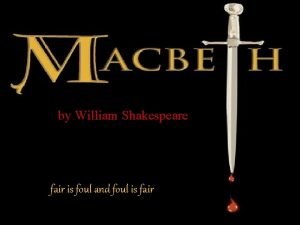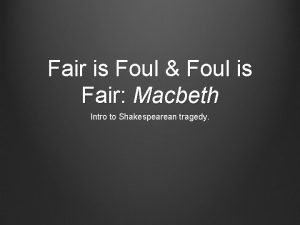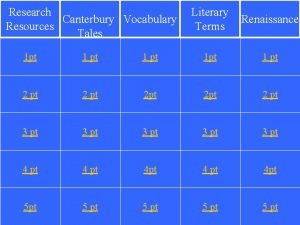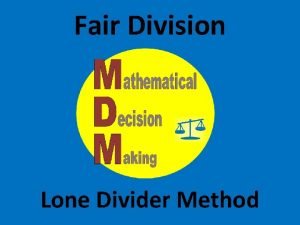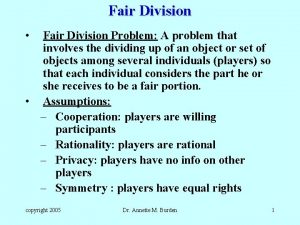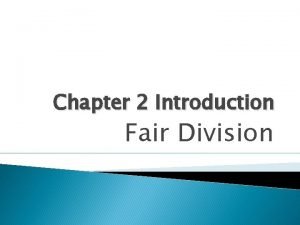Fair Division Estate Division Estate Division A fair










- Slides: 10

Fair Division Estate Division

Estate Division A fair division problem can be either discrete or continuous. l Dividing a house among heirs and dividing seats among student council are examples of discrete case. l Discrete divisions occur whenever objects cannot be meaningfully separated into pieces. l Dividing a cake is continuous. l

Fair Division Today we will look at how estates are divided fairly between heirs. l We will use an algorithm for dividing an estate among heirs, that produces an interesting paradox. l

Estate Division Algorithm 1. 2. Each heir submits a bid for each item in the estate. Bids are not made on cash in the estate because it is a continuous medium that can be divided equally without controversy. A fair share is determined for each heir by finding the sum of his or her bids and dividing this sum, by the number of heirs.

Estate Division Algorithm (cont’d) 3. 4. 5. Each item in the estate is given to the heir who bid the highest on that item. Each heir is given an amount of cash from the estate that is equal to his or her share (from Step 2) less the amount that the heir bid on the objects he or she received. If this amount is negative, the heir pays that amount into the estate. The remaining cash in the estate is divided equally among the heirs.

Example l Amanda, Brian and Charlene are heirs to an estate that includes a house, a boat, a car, and $75, 000 in cash. Each submits a bid for the house, boat and car. The bids are summarized in the following table. House Boat Car Amanda $40, 000 $3, 000 $5, 000 Brian $35, 000 $8, 000 Charlene $38, 000 $4, 000 $9, 000

Example (cont’d) The entries in Amanda’s row, for example, indicate the value to Amanda of each item in the estate. l A fair share is determined for each heir. l Amanda: ($40, 000 + $3, 000 + $5, 000 +$75, 000)/3 =$41, 000 Brian: ($35, 000 + $8, 000 +$75, 000)/3 =$41, 000 Charlene: ($38, 000 + $4, 000 + $9, 000 +$75, 000)/3 =$42, 000

Example (cont’d) l The house is given to Amanda, the boat to Brian and the car to Charlene. Cash equal to the difference between the fair share and the value of the awarded items is given to each heir. Amanda: $41, 000 -$40, 000=$1, 000 Brian: $41, 000 -$5, 000=$36, 000 Charlene: $42, 000 -$9, 000=$33, 000

Example (cont’d) The cash given to the heirs totals $70, 000 and the remaining $5, 000 is divided equally. l Thus each heir receives $1666. 67, more than a fair share. l Notice that each person receives more than a fair share of the estate. l

Fair Division Algorithm l The application of any fair division algorithm requires certain assumptions, or axioms. For example, the success of the estate division algorithm requires that each heir place a value on each object in the estate. If any heir considers an object priceless, the algorithm will fail.
 Examples of fair is foul and foul is fair in macbeth
Examples of fair is foul and foul is fair in macbeth Foul is fair macbeth
Foul is fair macbeth Every fair from fair sometime declines infinitive
Every fair from fair sometime declines infinitive Syntax literary devices
Syntax literary devices Foul is fair and fair is foul literary device
Foul is fair and fair is foul literary device Fair play slide
Fair play slide Literary devices in macbeth examples
Literary devices in macbeth examples Divider method
Divider method Method of markers
Method of markers Synthetic dividend
Synthetic dividend Long division how to
Long division how to
